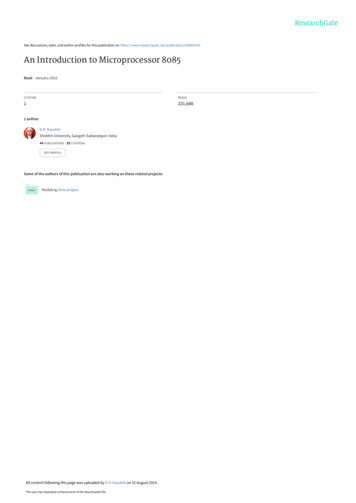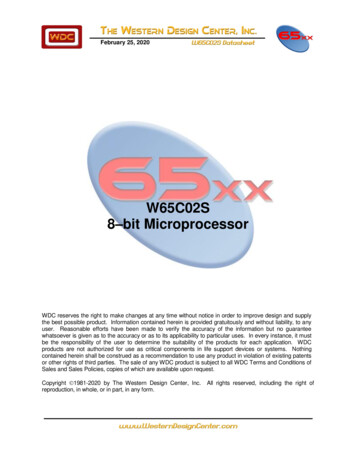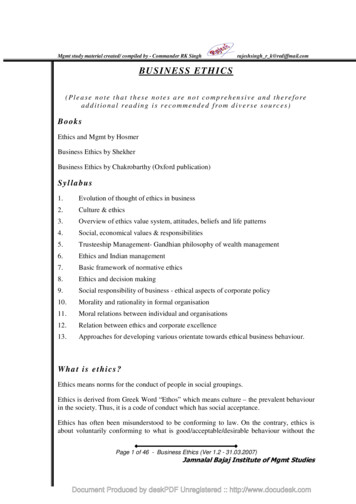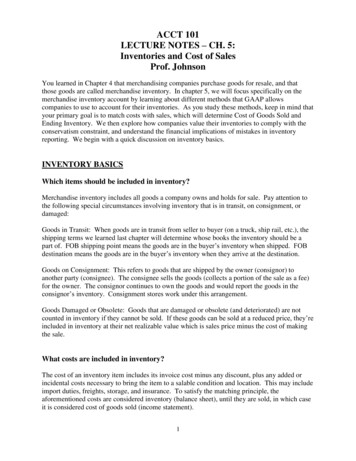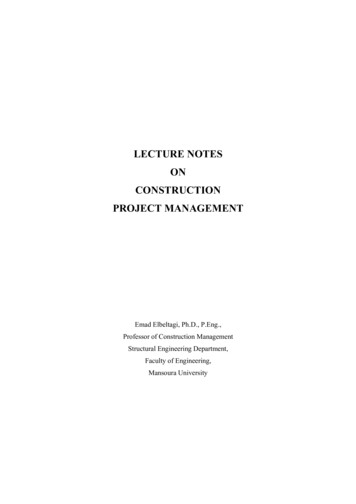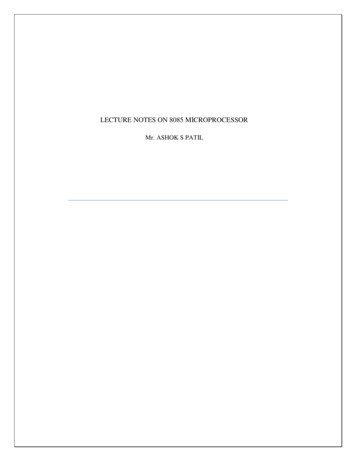
Transcription
LECTURE NOTES ON 8085 MICROPROCESSORMr. ASHOK S PATIL
CHAPTER: 1History of microprocessor:The invention of the transistor in 1947 was a significant development in the world of technology. It could perform thefunction of a large component used in a computer in the early years. Shockley, Brattain and Bardeen are credited with this inventionand were awarded the Nobel prize for the same. Soon it was found that the function this large component was easily performed by agroup of transistors arranged on a single platform. This platform, known as the integrated chip (IC), turned out to be a very crucialachievement and brought along a revolution in the use of computers. A person named Jack Kilby of Texas Instruments was honoredwith the Nobel Prize for the invention of IC, which laid the foundation on which microprocessors were developed. At the same time,Robert Noyce of Fairchild made a parallel development in IC technology for which he was awarded the patent.ICs proved beyond doubt that complex functions could be integrated on a single chip with a highly developed speed andstorage capacity. Both Fairchild and Texas Instruments began the manufacture of commercial ICs in 1961. Later, complexdevelopments in the IC led to the addition of more complex functions on a single chip. The stage was set for a single controllingcircuit for all the computer functions. Finally, Intel corporation's Ted Hoff and Frederico Fagin were credited with the design of thefirst microprocessor.The work on this project began with an order from a Japanese calculator company Busicom to Intel, for building some chips for it.Hoff felt that the design could integrate a number of functions on a single chip making it feasible for providing the requiredfunctionality. This led to the design of Intel 4004, the world's first microprocessor. The next in line was the 8 bit 8008microprocessor. It was developed by Intel in 1972 to perform complex functions in harmony with the 4004.This was the beginning of a new era in computer applications. The use of mainframes and huge computers was scaled down to amuch smaller device that was affordable to many. Earlier, their use was limited to large organizations and universities. With theadvent of microprocessors, the use of computers trickled down to the common man. The next processor in line was Intel's 8080 withan 8 bit data bus and a 16 bit address bus. This was amongst the most popular microprocessors of all time.Very soon, the Motorola corporation developed its own 6800 in competition with the Intel's 8080. Fagin left Intel and formed his ownfirm Zilog. It launched a new microprocessor Z80 in 1980 that was far superior to the previous two versions. Similarly, a break offfrom Motorola prompted the design of 6502, a derivative of the 6800. Such attempts continued with some modifications in the basestructure.The use of microprocessors was limited to task-based operations specifically required for company projects such as the automobilesector. The concept of a 'personal computer' was still a distant dream for the world and microprocessors were yet to come intopersonal use. The 16 bit microprocessors started becoming a commercial sell-out in the 1980s with the first popular one being theTMS9900 of Texas Instruments.
Intel developed the 8086 which still serves as the base model for all latest advancements in the microprocessor family. Itwas largely a complete processor integrating all the required features in it. 68000 by Motorola was one of the firstmicroprocessors to develop the concept of microcoding in its instruction set. They were further developed to 32 bitarchitectures. Similarly, many players like Zilog, IBM and Apple were successful in getting their own products in themarket. However, Intel had a commanding position in the market right through the microprocessorera.The 1990s saw a large scale application of microprocessors in the personal computer applications developed by the newlyformed Apple, IBM and Microsoft corporation. It witnessed a revolution in the use of computers, which by then was ahousehold entity.This growth was complemented by a highly sophisticated development in the commercial use of microprocessors. In 1993,Intel brought out its 'Pentium Processor' which is one of the most popular processors in use till date. It was followed by aseries of excellent processors of the Pentium family, leading into the 21st century. The latest one in commercial use is thePentium Dual Core technology and the Xeon processor. They have opened up a whole new world of diverse applications.Supercomputers have become common, owing to this amazing development in microprocessors.INTRODUCTION TO MICROPROCESSOR AND MICROCOMPUTERARCHITECTURE:A microprocessor is a programmable electronics chip that has computing and decision making capabilities similar tocentral processing unit of a computer. Any microprocessor-based systems having limited number of resources are calledmicrocomputers. Nowadays, microprocessor can be seen in almost all types of electronics devices like mobile phones,printers, washing machines etc. Microprocessors are also used in advanced applications like radars, satellites and flights.Due to the rapid advancements in electronic industry and large scale integration of devices results in a significant costreduction and increase application of microprocessors and their derivatives.Fig.1 Microprocessor-based system Bit: A bit is a single binary digit. Word: A word refers to the basic data size or bit size that can be processed by the arithmetic and logic unit ofthe processor. A 16-bit binary number is called a word in a 16-bit processor. Bus: A bus is a group of wires/lines that carry similar information. System Bus: The system bus is a group of wires/lines used for communication between the microprocessor andperipherals. Memory Word: The number of bits that can be stored in a register or memory element is called a memory word. Address Bus: It carries the address, which is a unique binary pattern used to identify a memory location or an I/O port. For example, an eight bit address bus has eight lines and thus it can address 2 8 256 different locations. The locations in hexadecimal format can be written as 00H – FFH. Data Bus: The data bus is used to transfer data between memory and processor or between I/O device andprocessor. For example, an 8-bit processor will generally have an 8-bit data bus and a 16-bit processor will have16-bit data bus. Control Bus: The control bus carry control signals, which consists of signals for selection of memory or I/Odevice from the given address, direction of data transfer and synchronization of data transfer in case of slowdevices.
A typical microprocessor consists of arithmetic and logic unit (ALU) in association with control unit to process theinstruction execution. Almost all the microprocessors are based on the principle of store-program concept. In storeprogram concept, programs or instructions are sequentially stored in the memory locations that are to be executed. To doany task using a microprocessor, it is to be programmed by the user. So the programmer must have idea about its internalresources, features and supported instructions. Each microprocessor has a set of instructions, a list which is provided bythe microprocessor manufacturer. The instruction set of a microprocessor is provided in two forms: binary machine codeand mnemonics.Microprocessor communicates and operates in binary numbers 0 and 1. The set of instructions in the form of binarypatterns is called a machine language and it is difficult for us to understand. Therefore, the binary patterns are givenabbreviated names, called mnemonics, which forms the assembly language. The conversion of assembly-level languageinto binary machine-level language is done by using an application called assembler.Technology Used:The semiconductor manufacturing technologies used for chips are: Transistor-Transistor Logic (TTL) Emitter Coupled Logic (ECL) Complementary Metal-Oxide Semiconductor (CMOS)Classification of Microprocessors: Based on their specification, application and architecture microprocessors are classified.Based on size of data bus: 4-bit microprocessor 8-bit microprocessor 16-bit microprocessor 32-bit microprocessor Based on application: General-purpose microprocessor- used in general computer system and can be used by programmer for anyapplication. Examples, 8085 to Intel Pentium. Microcontroller- microprocessor with built-in memory and ports and can be programmed for any generic controlapplication. Example, 8051. Special-purpose processors- designed to handle special functions required for an application. Examples, digitalsignal processors and application-specific integrated circuit (ASIC) chips.
Based on architecture: Reduced Instruction Set Computer (RISC) processors Complex Instruction Set Computer (CISC) processors 2. 8085 MICROPROCESSOR ARCHITECTUREThe 8085 microprocessor is an 8-bit processor available as a 40-pin IC package and uses 5 V for power. It can run at amaximum frequency of 3 MHz. Its data bus width is 8-bit and address bus width is 16-bit, thus it can address 216 64 KBof memory. The internal architecture of 8085 is shown is Fig. 2.Fig. 2 Internal Architecture of 8085Arithmetic and Logic UnitThe ALU performs the actual numerical and logical operations such as Addition (ADD), Subtraction (SUB), AND, ORetc. It uses data from memory and from Accumulator to perform operations. The results of the arithmetic and logicaloperations are stored in the accumulator.RegistersThe 8085 includes six registers, one accumulator and one flag register, as shown in Fig. 3. In addition, it has two 16-bitregisters: stack pointer and program counter. They are briefly described as follows.The 8085 has six general-purpose registers to store 8-bit data; these are identified as B, C, D, E, H and L. they can becombined as register pairs - BC, DE and HL to perform some
16- bit operations. The programmer can use these registers to store or copy data into the register by using data copyinstructions.Fig. 3 Register organisationAccumulatorThe accumulator is an 8-bit register that is a part of ALU. This register is used to store 8-bit data and to perform arithmeticand logical operations. The result of an operation is stored in the accumulator. The accumulator is also identified asregister A.Flag registerThe ALU includes five flip-flops, which are set or reset after an operation according to data condition of the result in theaccumulator and other registers. They are called Zero (Z), Carry (CY), Sign (S), Parity (P) and Auxiliary Carry (AC) flags.Their bit positions in the flag register are shown in Fig. 4. The microprocessor uses these flags to test data conditions.Fig. 4 Flag registerFor example, after an addition of two numbers, if the result in the accumulator is larger than 8-bit, the flip-flop uses toindicate a carry by setting CY flag to 1. When an arithmetic operation results in zero, Z flag is set to 1. The S flag is just acopy of the bit D7 of the accumulator. A negative number has a 1 in bit D7 and a positive number has a 0 in 2’scomplement representation. The AC flag is set to 1, when a carry result from bit D3 and passes to bit D4. The P flag is setto 1, when the result in accumulator contains even number of 1s.
Program Counter (PC)This 16-bit register deals with sequencing the execution of instructions. This register is a memory pointer. Themicroprocessor uses this register to sequence the execution of the instructions. The function of the program counter is topoint to the memory address from which the next byte is to be fetched. When a byte is being fetched, the program counteris automatically incremented by one to point to the next memory location.Stack Pointer (SP)The stack pointer is also a 16-bit register, used as a memory pointer. It points to a memory location in R/W memory, calledstack. The beginning of the stack is defined by loading 16-bit address in the stack pointer.Instruction Register/DecoderIt is an 8-bit register that temporarily stores the current instruction of a program. Latest instruction sent here from memoryprior to execution. Decoder then takes instruction and decodes or interprets the instruction. Decoded instruction thenpassed to next stage.Control UnitGenerates signals on data bus, address bus and control bus within microprocessor to carry out the instruction, which hasbeen decoded. Typical buses and their timing are described as follows: Data Bus: Data bus carries data in binary form between microprocessor and other external units such as memory.It is used to transmit data i.e. information, results ofarithmetic etc between memory and the microprocessor. Data bus is bidirectional in nature. The data bus widthof 8085 microprocessor is 8-bit i.e. 28 combination of binary digits and are typically identified as D0 – D7. Thussize of the data bus determines what arithmetic can be done. If only 8-bit wide then largest number is 11111111(255 in decimal). Therefore, larger numbers have to be broken down into chunks of 255. This slowsmicroprocessor. Address Bus: The address bus carries addresses and is one way bus from microprocessor to the memory or otherdevices. 8085 microprocessor contain 16-bit address bus and are generally identified as A0 - A15. The higherorder address lines (A8 – A15) are unidirectional and the lower order lines (A0 – A7) are multiplexed (timeshared) with the eight data bits (D0 – D7) and hence, they are bidirectional. Control Bus: Control bus are various lines which have specific functions for coordinating and controllingmicroprocessor operations. The control bus carries control signals partly unidirectional and partly bidirectional.The following control and status signals are used by 8085 processor:I.ALE (output): Address Latch Enable is a pulse that is provided when an address appears on the AD0 –AD7 lines, after which it becomes 0.
II. RD
4-bit microprocessor 8-bit microprocessor 16-bit microprocessor 32-bit microprocessor Based on application: General-purpose microprocessor- used in general computer system and can be used by programmer for any application. Examples, 8085 to Intel Pentium. Microcontroller- microprocessor with built-in memory and ports and can be programmed for any generic control application. Example, 8051 .
